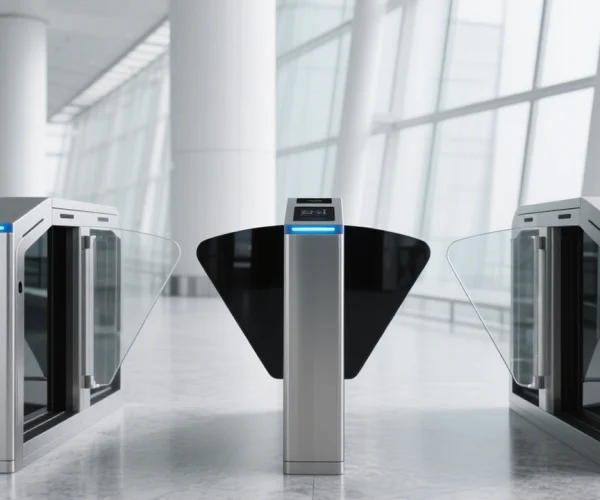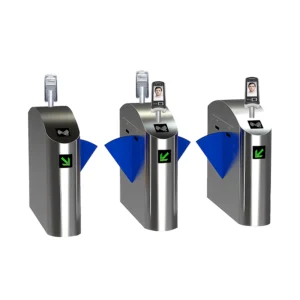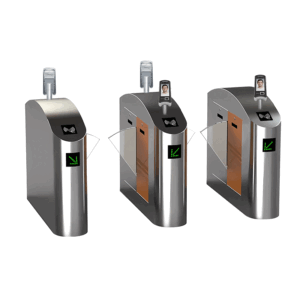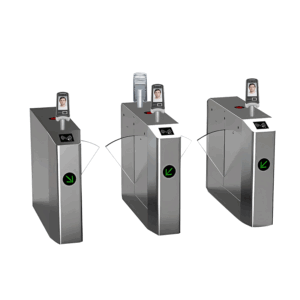Flap Barrier
In modern cities, people move rapidly through crowded public spaces. Offices, subways, airports, and stadiums handle thousands of entries every day. Without efficient access control, queues form quickly, and safety risks increase. Security checks must be fast, accurate, and non-intrusive to keep people moving. Therefore, many facilities seek solutions that combine speed and security. Flap barriers meet this need by offering quick passage, precise verification, and a modern appearance. With advanced sensors, intelligent control, and sleek designs, they provide both safety and convenience in high-traffic environments.
What Is a Flap Barrier?
A flap barrier is a type of entrance control gate that uses retractable wings to manage passage. These wings are often made of acrylic or tempered glass for a clean, modern look. When a valid signal is detected, the wings retract instantly, allowing one person to pass. After passage, the wings close to secure the lane again. Flap barriers work with multiple identification methods, including RFID cards, QR codes, and biometric recognition. They feature key components such as a cabinet, control board, motor mechanism, and safety sensors. The sensors detect movement and prevent accidents, ensuring a smooth and secure experience.
In advanced models, the system integrates with building management and ticketing platforms. This allows centralized control, real-time monitoring, and data collection for better crowd management. Many designs also support modular upgrades, enabling future compatibility with new technologies like AI facial analysis.
Key Features of Flap Barriers
High Speed
They can process 30–40 people per minute, effectively reducing congestion during peak hours. This ensures smooth entry in subways, offices, and busy public facilities.
Strong Security
Anti-tailgating and anti-reverse entry systems prevent unauthorized access. They maintain order by detecting attempts to bypass the gate.
Safety Protection
Advanced sensors prevent the wings from closing on users. They also detect objects or luggage in the lane, reducing accidents.
Multiple Access Modes
Supports ID cards, QR codes, fingerprint, and facial recognition. Facilities can choose the method that best fits security and convenience needs.
Compact Design
Requires less space compared to swing gates. The slim profile fits narrow entrances while maintaining smooth pedestrian flow.
Low Maintenance
Durable materials and reliable motors reduce downtime. Routine checks are simple, lowering long-term operational costs.
Differences Between Flap Barriers and Swing Gates
Flap barriers and swing gates are both widely used in access control, but they serve different purposes. Flap barriers feature retractable panels that move vertically, allowing fast passage in high-traffic environments. They are common in subway stations, airports, and stadiums, where speed and space efficiency are crucial. The compact design fits narrow entrances without slowing the flow of people.
Swing gates, on the other hand, use rotating arms or panels that swing open horizontally. They can accommodate wider passages and provide wheelchair access, making them ideal for offices, hospitals, and public institutions. Their softer visual profile blends easily with different architectural styles.
From a security perspective, flap barriers create a stronger physical and visual deterrent. They detect tailgating more effectively in fast-moving crowds. Swing gates focus on accessibility and comfort, handling mixed traffic such as people with luggage or equipment.
In summary, flap barriers are faster and more compact, making them perfect for high-traffic areas with strict security needs. Swing gates operate at a slower pace but allow wider lanes, making them better suited for environments prioritizing accessibility and inclusivity. Understanding these differences enables facility managers to choose the most suitable system for their specific requirements.

Application
Public Transportation
In subway stations, train terminals, and airports, flap barriers help manage massive passenger flows during peak hours. Their rapid open-and-close mechanism allows thousands of people to pass through in a short time without creating bottlenecks. Integrated ticket validation systems verify passengers’ credentials instantly, reducing queue times. In addition, their compact footprint fits narrow station entrances, leaving more room for pedestrian movement and safety markings. Flap barriers can also integrate with real-time monitoring systems, enabling transport operators to detect fare evasion or crowd surges immediately.
Corporate Campuses
Within large corporate campuses, flap barriers ensure that only authorized employees and registered visitors can access office buildings. By integrating with employee ID badges, mobile credentials, or biometric scanners, they eliminate the need for manual ID checks. They also serve as a first security layer, preventing unauthorized individuals from entering sensitive areas such as R\&D labs or data centers. In high-traffic lobbies, their fast operation keeps entry lines moving smoothly, even during morning rush hours. Flap barriers can also log entry data, supporting attendance tracking and security audits.
Government Institutions
In government facilities such as administrative offices, courthouses, or municipal buildings, flap barriers play a critical role in balancing security and efficiency. They can be linked with national ID databases for fast identity verification, ensuring only cleared personnel or pre-registered visitors enter restricted zones. When integrated with CCTV and visitor management systems, they allow real-time monitoring of all entries and exits, aiding in both security enforcement and operational transparency. Their sturdy build and tamper-resistant design provide reliable performance in high-security environments where access control is non-negotiable.
School Libraries
In university and school libraries, flap barriers help regulate access and protect resources. Students and faculty can enter by scanning their campus cards or using a mobile app, ensuring that only members of the institution have borrowing privileges. These systems can be linked to library databases, automatically updating records when users check in. In addition to access control, flap barriers also track visitor flow, allowing administrators to identify peak usage times and allocate resources accordingly. Their quiet operation ensures they do not disturb the study environment while maintaining effective entry management.
Factors to Consider When Choosing a Flap Barrier

Selecting the right flap barrier starts with analyzing pedestrian traffic. High-traffic areas require gates that operate quickly and reliably. Security needs are equally important, with anti-tailgating and anti-pinch features providing enhanced protection. The choice of authentication method matters, including ID cards, biometrics, QR codes, or mobile credentials. Integration with existing systems, such as CCTV, visitor management, and building controls, ensures seamless operation. Entrance width and available space influence the design; compact gates suit narrow passages, while wider lanes improve flow. Aesthetics also play a role, as materials, finishes, and LED indicators should match the environment. Environmental conditions, like indoor or semi-outdoor installations, determine the need for weather-resistant or durable components. Finally, maintenance requirements and product lifespan affect long-term efficiency and cost. Considering all these factors helps facilities select a flap barrier that balances security, convenience, and smooth operation.
Future Trends in Flap Barrier Technology
Flap barriers continue to evolve with advancements in AI, IoT, and smart building integration. Touchless authentication, including facial recognition and mobile credentials, is becoming standard, improving speed and hygiene. Edge AI allows gates to verify identities instantly without relying solely on cloud systems, enhancing resilience and reliability. Integration with digital twin models enables facility managers to simulate pedestrian flows and optimize layouts before installation. Sustainability is also a growing focus, with energy-efficient motors, low-power standby modes, and recyclable materials extending product lifecycles. Modular designs allow easy upgrades, ensuring gates remain compatible with emerging identification technologies. Future flap barriers will not only secure access but also collect and analyze data to improve operational efficiency. These innovations point toward smarter, greener, and more connected access control systems, deeply embedded into modern building infrastructure.
Company Expertise and Product Advantages




Our company specializes in high-quality flap barrier solutions for diverse industries. We design gates to combine speed, durability, and advanced safety features. Our products support multiple authentication methods, including ID cards, biometrics, QR codes, and mobile credentials. Customization options are available for materials, finishes, and LED indicators to match client requirements. Each installation is backed by professional technical support and comprehensive after-sales service. Modular designs simplify maintenance and future upgrades, minimizing downtime and costs. By choosing our flap barriers, clients enhance security, streamline pedestrian flow, and reflect a modern, professional image. Our solutions help facilities stay efficient, adaptable, and ready for future technological developments.
